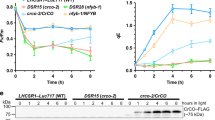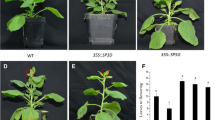Abstract
Fourteen genes encoding proteins of the light harvesting complex (Lhc) are expressed in a photoautotrophic cell culture from the wild species of tomato (Lycopersicon peruvianum). For two genes, Lhca2 (cab7) and Lhcb2*1 (cab4), a rhythmic oscillation of the transcript accumulation is observed under light/dark and constant dark conditions indicating that gene expression is controlled by a circadian clock in the tomato cell culture. The circadian expression of the Lhc genes remains present after application of 2,2′-dipyridyl. However, the amplitude of Lhc mRNA oscillations and the photosynthetic capacity (Fmax/Fo) decrease significantly. The transcript accumulations of psbA, rbcS and rbcL are less or not at all affected by 2,2′-dipyridyl.
Similar content being viewed by others
References
Apel K and Kloppstech K (1978) The plastid membranes of barley (Hordeum vulgare). Light induced appearance of mRNA coding for the apoprotein of the light-harvesting chlorophyll a/b protein. Eur J Biochem 85: 581–588
Apel K and Kloppstech K (1980) The effect of light on the biosynthesis of the light harvesting chlorophyll a/b protein. Evidence for the requirement of chlorophyll a for the stabilization of the apoprotein. Planta 150: 426–430
Beator J and Kloppstech K (1993) The circadian oscillator coordinates the synthesis of apoproteins and their pigments during chloroplast development. Plant Physiol 103: 191–196
Beator J, Pötter E and Kloppstech K (1992) The effect of heat shock on morphogenesis in barley. Coordinated circadian regulation of mRNA levels for light-regulated genes and of the capacity for accumulation of chlorophyll protein complexes. Plant Physiol 100: 1780–1786
Castelfranco PA and Beale SI (1983) Chlorophyll biosynthesis: Recent advances and areas of current interest. Plant Physiol 34: 241–278
Fromm H, Devic M, Fluhr R and Edelman M (1985) Control of psb A gene expression: In mature Spirodela chloroplasts light regulation of 32-kd protein synthesis is independent of transcript level. EMBO J 4: 291–295
Hermsmeier D, Schulz R and Senger H (1994) Formation of light-harvesting complexes of Photosystem II in Scenedesmus. Planta 193: 398–405
Hüsemann W and Barz W (1977) Photoautotrophic growth and photosynthesis in cell suspension cultures of Chenopodium rubrum. Physiol Plant 40: 77–81
Jansson S, Pichersky E, Bassi R, Green BR, Ikeuchi M, Melis A, Simpson DJ, Spangfort M, Staehelin LA and Thornber JP (1992) A nomenclature for the genes encoding the chlorophyll a/b-binding proteins of higher plants. Plant Mol Biol Rep 10: 242–253
Jansson S (1994) The light-harvesting chlorophyll a/b-binding proteins. Biochem Biophys Acta 1184: 1–19
Kellmann JW, Pichersky E and Piechulla B (1990) Analysis of the diurnal expression pattems of the tomato chlorophyll a/b binding protein genes. Influence of light and characterization of the gene family. Photochem Photobiol 52: 35–41
Kellmann JW, Merforth N, Wiese M, Pichersky E, Piechulla B (1993) Concerted circadian oscillations in transcript levels of nineteen Lha/b (cab) genes in Lycopersicon esculentum (tomato). Mol Gen Genet 237: 439–448
Kühlbrandt W, Wang DN and Fujiyoshi Y (1994) Atomic model of plant light-harvesting complex by electron crystallography. Nature 367: 614–621
Meyer H, Thienel U and Piechulla B (1989) Molecular characterization of the diurnal/circadian expression of the chlorophyll a/b-binding proteins in leaves of tomato and other dicotyledonous and monocotyledonous plant species. Planta 180: 5–15
Oberschmidt O, Hücking C and Piechulla B (1995) Diurnal Lhc gene expression is present in many but not all species of the plant kingdom. Plant Mol Biol 27: 147–153
Pichersky E, Hoffman NE, Malik VS, Bernatzky R, Tanksley SD, Szabo L and Cashmore AR (1987) The tomato cab-4 and cab-5 genes encode a second type of CAB polypeptids in Photosystem II. Plant Mol Biol 9: 109–120
Pichersky E, Tanksley SD, Piechulla B, Stayton MM, Dunsmuir P (1988) Nucleotide sequence and chromosomal location of cab-7, the tomato gene encoding the type II chlorophyll a/b-binding polypeptide of Photosystem I. Plant Mol Biol 11: 69–71
Piechulla B and Gruissem W (1987) Diurnal mRNA fluctuations of nuclear and plastid genes in developing tomato fruits. EMBO J 6: 3593–3599
Piechulla B (1993) ‘Circadian clock’ directs the expression of plant genes. Plant Mol Biol 22: 533–542
Piechulla B, Pichersky E, Cashmore AR and Gruissem W (1986) Expression of nuclear and plastid genes for photosynthesis-specific proteins during tomato fruit development and ripening. Plant Mol Biol 7: 367–376
Prasil O, Adir N and Ohad I (1992) Dynamics of Photosystem II: mechanism of photoinhibition and recovery processes. In: Barber J (ed) Topics in Photosynthesis 11, pp 295–348. Elsevier, Amsterdam
Preiss S and Thornber JP (1995) Stability of the apoproteins of light-harvesting complex I and II during biogenesis of thylakoids in the chlorophyll b-less barley mutant chlorina f2. Plant Physiol 107: 709–717
Riesselmann S and Piechulla B (1992) Diurnal and circadian light-harvesting complex and quinone B-binding protein synthesis in leaves of tomato (Lycopersicon esculentum). Plant Physiol 100: 1840–1845
Schreiber U, Schliwa U and Bilger W (1986) Continuous recording of photochemical and non-photochemical chlorophyll fluorescence quenching with a new type of modulation fluorometer. Photosynth Res 10: 51–62
Stöcker S (1993) Etablierung und Charakterisierung photosynthetisch aktiver Kallus- und Suspensionskulturen von Potato Spindle Tuber Viroid-infizierten und uninfizierten Tomatenzellen (Lycopersicon esculentum Mill). Dissertation, University of Hamburg, Germany
Stöcker S, Guitton MC, Barth A, Mühlbach HP (1993) Photosynthetical active suspension cultures of potato spindle viroid infected tomato cells as tools for studying viroid-host cell interaction. Plant Cell Rep 12: 597–602
Tanaka A, Tanaka Y and Tsuji H (1994) Preferential accumulation of apoproteins of the light-harvesting chlorophyll a/b-protein complex in greening barley leaves treated with 5-aminolevulinic acid. Planta 192: 92–97
Terao T and Katoh S (1989) Synthesis and breakdown of the apoproteins of light-harvesting chlorophyll a/b proteins in chlorophyll b-deficient mutants of rice. Plant Cell Physiol 30: 571–580
Ziegler R and Egle K (1965) Zur quantitativen Analyse der Chloroplastenpigmente. I. Kritische Überprüfung der spektralphotometrischen Chlorophyll-Bestimmung. Beitr Biol Pflanzen 41: 11–37
Author information
Authors and Affiliations
Rights and permissions
About this article
Cite this article
Winter, L., Stöcker, S., Merforth, N. et al. Circadian oscillations of Lhc mRNAs in a photoautotrophic cell culture of Lycopersicon peruvianum . Photosynth Res 47, 77–84 (1996). https://doi.org/10.1007/BF00017755
Received:
Accepted:
Issue Date:
DOI: https://doi.org/10.1007/BF00017755




